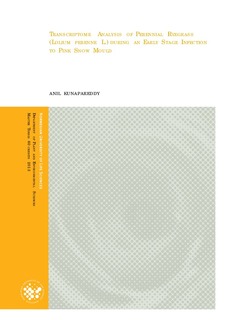| dc.description.abstract | Microdochium nivale causes pink snow mould disease that damages forage grasses (especially perennial ryegrass) covered by snow, particularly in late winter. This makes the survival of perennial ryegrass (Lolium perenne L.), which is an economically important forage grass in Europe, difficult. Resistance mechanisms against pink snow mould disease is not fully understood. Thus, to gain a better understanding of resistance mechanisms in perennial ryegrass, we investigated variation in resistance among L. perenne genotypes, measured as relative regrowth after inoculation with several M. nivale isolates, and conducted a global transcriptome study of resistant and susceptible genotypes using an RNA sequencing approach. Ten genotypes, 8 from the Norwegian cultivar genotypes Fagerlin and 2 from the European cultivar Picaro, were used in this study. Clones of ten genotypes were inoculated with M. nivale isolates and incubated in darkness at 2°C for 5-12 weeks. Relative regrowth was calculated as the ratio of the regrowth of inoculated and non-inoculated plants after 5, 8 and 12 weeks of incubation. Based on relative regrowth one ‘resistant’ genotype (M) and one ‘susceptible’ genotype (F) were selected for transcriptome studies. Total RNA was extracted from the leaf blade tissue of plants exposed to three different treatments: non-inoculated and non-incubated plants (non-incubated control), non-inoculated plants after 4 days of incubation (incubated control), and inoculated plants after 4 days of incubation (inoculated). There were two biological replicates of each genotype and treatment (totally 12 samples). cDNA libraries were prepared and paired-end sequencing was performed using Illumina Hiseq 2000. Before sequencing, qPCR was performed with the candidate gene PR-5 (thaumatin-like protein), a gene which is expressed in response to pathogen attack. The results indicate that there is significant variation among M and F genotypes during 0 day and the 4th day. Higher transcript levels of PR-5 were observed in both non-incubated control (0 day) and inoculated (4th day) plants of the ‘resistant’ M genotype than in the ‘susceptible’ F genotype. This variation in the expression of PR-5 indicates that the two selected genotypes are different in respect to resistance against pink snow mould, and that they are suitable for being used for global RNA sequencing. De-novo assembly was done using the Trinity software platform. A total number of 188,355 and 261,978 assembled contigs with N50 values of 1,672 and 1,784 bp were generated from the “M” and “F” genotypes, respectively. Mapping was done by aligning the reads back to the assemble contigs using the Bowtie program and then transcript abundance was estimated by RSEM. Using EdgeR, differential expression analysis of read counts was done. A total number of 7,282 and 19,055 significantly differentially expressed (DE) genes were detected between non-incubated control and inoculated (incubated at 2°C), 6,227 and 19,832 DE genes were detected between non-incubated control and non-inoculated plants, and 275 and 83 DE genes were detected between inoculated and non-inoculated plants of the “M” and “F” genotypes, respectively. In this study we mainly focused on gene expression in inoculated and non-inoculated incubated plants as they were treated under the same conditions, i.e. incubation in darkness. DE genes from the ‘resistant’ (M) genotype and from the ‘susceptible’ (F) genotype were blasted and annotated against the NCBI non-redundant database using Blast2go program. The annotation results gave us about various genes that are differentially expressed at various stress factors. Further detailed studies on these genes will help us to understand the interactions between perennial ryegrass plants and M. nivale and also provied information that can be used to develop cultivars with improved resistance against pink snow mould by studying expressions of various defence related genes. | no_NO |
